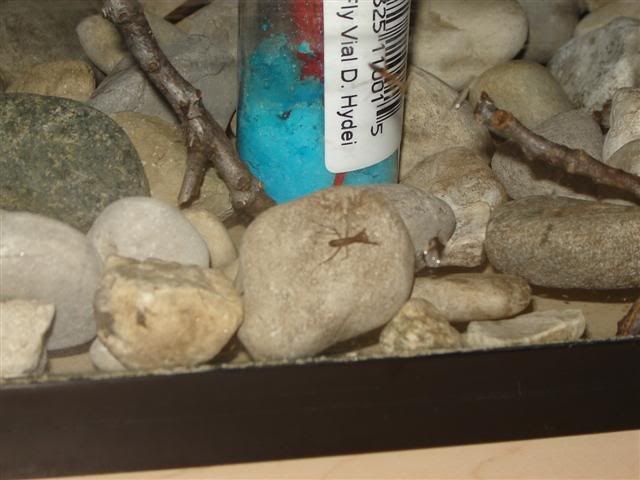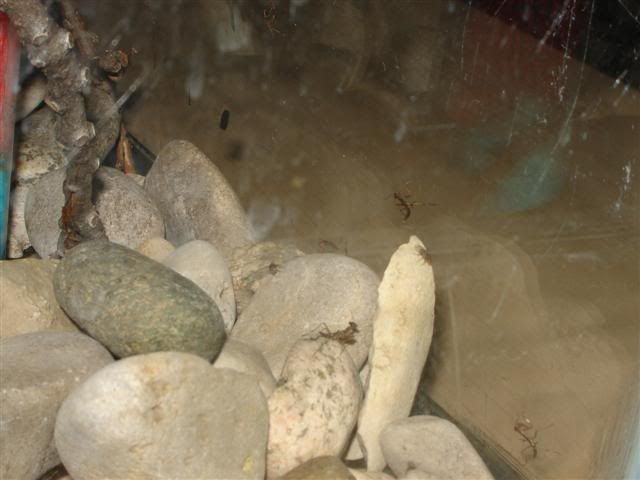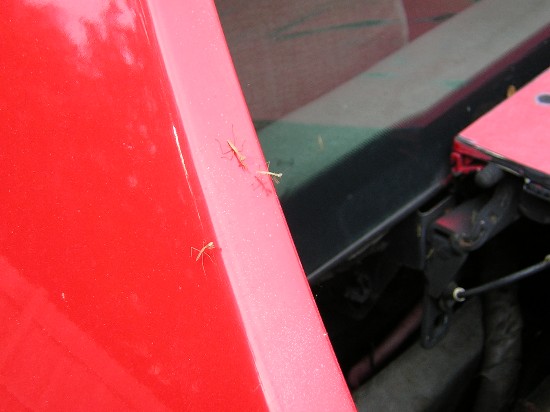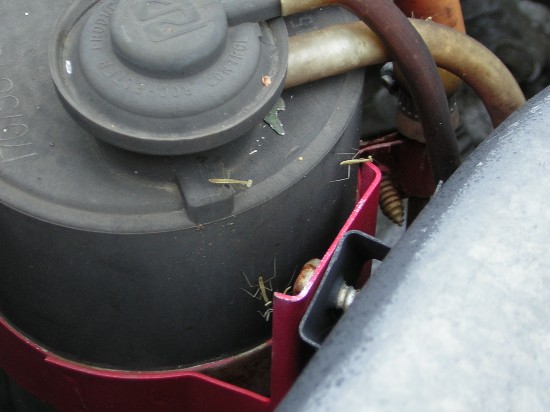Glad I'm not a male orb-weaving spider!

From the NY Times:
This Can’t Be Love
By CARL ZIMMER
Published: September 5, 2006
Across the eastern United States, a gruesome ritual is in full swing. The praying mantis and its relative, the Chinese mantis, are in their courtship season. A male mantis approaches a female, flapping his wings and swaying his abdomen. Leaping on her back, he begins to mate. And quite often, she tears off his head.
The female mantis devours the head of the still-mating male and then moves on to the rest of his body. “If you put a pair together and come back later, you’ll just find the wings of the male and no other evidence he was ever there,” said William Brown, an evolutionary biologist at the State University of New York in Fredonia.
Sexual cannibalism has fascinated biologists ever since Darwin. It is not limited to mantises, but is also found in other invertebrates, including spiders, midges and perhaps horned nudibranchs.
Biologists have debated how this behavior has evolved in these species. Some have suggested that sexual cannibalism is just a result of a voracious female appetite. But experiments have also suggested that it is a strategy that females use to select the best fathers for their offspring.
Other scientists have found evidence that males may have had a role in the evolution of cannibalism. By surrendering themselves to their mates, males increase their reproductive success. Still other scientists have proposed that males actually go to great lengths to minimize their risk of being eaten.
As scientists look more closely at sexual cannibalism in many species, the emerging consensus is that all of these theories may be right. Different evolutionary pressures produce sexual cannibalism in different species.
“It’s not something that lends itself to a single, simple explanation,” said Mark Elgar of the University of Melbourne.
Sexual cannibalism became a hot topic of debate among biologists in 1984. Scientists from Cornell and the University of Texas at Austin proposed that it evolved because the males of some species could get an evolutionary advantage from being eaten. Their bodies could nourish the mothers of their offspring, raising the odds that those offspring would successfully hatch and grow up to produce their own offspring, thus carrying on the father’s genes.
The late Harvard biologist Stephen Jay Gould attacked this argument, calling it a prime example of how biologists had become “overzealous about the power and range of selection by trying to attribute every significant form and behavior to its direct action.”
Dr. Gould argued that sexual cannibalism was too rare to be significant. It is possible, he said, that females eat their mates simply because they mistake them for prey.
Subsequent research refuted parts of Dr. Gould’s argument. Some sexual cannibals, including female Chinese mantises, actually eat a lot of males. “One study estimated that 63 percent of the diet of females are male mantids,” Dr. Brown said. “So they’re the main food source.”
Other scientists have demonstrated that males can increase their chances of passing on their genes if they cooperate in their own death.
Male Australian redback spiders court females for up to eight hours by plucking the strands of their web. Once a male starts to mate, he promptly somersaults onto her fangs. He continues to mate as she feeds on him. In some cases, the male crawls a short distance away, courts the female again, and then mates a second time. He flips onto her fangs, and by the end of the second mating he is dead.
Male redback spiders benefit from cannibalism, but not because they can become food for their mates. Instead, Dr. Maydianne Andrade of the University of Toronto has found that males that are cannibalized mate more than twice as long as noncannibalized males. They also father twice as many offspring with a female that mates with other males.
“We’ve replicated the results three times — it’s definitely going on,” Dr. Andrade said.
Cannibalism provides males extra time to put a plug in a female’s sperm receptacle, Dr. Andrade’s research suggests. The plug prevents other males from fertilizing the female, thus raising the odds that the first male’s sperm will.
“It has to be placed quite precisely for it to function as a sperm plug,” Dr. Andrade said.
Male redback spiders, which have two sexual organs, also have adaptations to let them survive cannibalism long enough to mate twice. Female spiders have two receptacles, each of which must be fertilized by separate male organs. If a male redback dies before he has a chance to fertilize the second receptacle, his reproductive success plummets by half.
Dr. Andrade and her student Jeff Stoltz noticed that male redback spiders develop a pinched abdomen before they mate. “Imagine putting a belt around it and cinching it tight,” Dr. Andrade said. “It’s really striking, and it develops long before the males even touch the females.”
To understand why the spiders developed this belt, the scientists delivered wounds to male redbacks to mimic female cannibalism. They found that males that had developed the constriction survived longer and mated more successfully than males that had not.
Sexual cannibalism has been reported in the midge as well. Some believe that natural selection or perhaps simply appetite is behind the practice.
The constriction may help males survive by pushing the heart and other vital organs away from the female’s fangs. It may also reduce the flow of fluids out of the spider’s body.
Scientists have found other species in which males encourage their own cannibalism. One remarkable twist on this strategy is seen in a species of orb-weaving spiders. The males suddenly die as they mate. The male’s death may be a strategy for preventing other males from mating with the female. In death, its sexual organ becomes stuck in the female’s receptacle. Even if she feeds on the rest of his body, the organ remains behind, preventing her from receiving more sperm.
Some scientists are now investigating what sort of evolutionary pressures cause males to go along with their own demise. In some species, males have very few opportunities to mate, while each female may mate with multiple males. For these desperate males, the benefits of sacrificing themselves may outweigh the loss of future opportunities to mate. Dr. Andrade describes the strategy this way: “If you don’t have any other shot at it, do what you can now.”
Recently, Dr. Brown of SUNY Fredonia set out to test whether male Chinese mantises are complicit in their own deaths. Females clearly eat a lot of male mantids, but that does not necessarily mean that the males benefit. Dying while mating with one female robs them of the chance to mate with other females.
Dr. Brown decided to observe whether males did anything to increase their odds of survival during mating. Since hungrier females are more likely to eat their mates, he reasoned that males might approach hungry females differently from fed ones.
“We predicted that if the male is complicit, he’s just going to march into her jaws,” Dr. Brown said. “But if the male does not want to become her meal, then he should avoid the risk of being eaten.”
Dr. Brown and his undergraduate student Jonathan Lelito (now a graduate student at the University of Pittsburgh) placed males into containers with females. In some cases, the females had just feasted on crickets, and in other cases they were ravenous.
Male mantises responded very differently to hungry females and to full ones. They were more eager to approach full ones than hungry ones. When they did approach hungry females, they jumped onto their mates from farther away, possibly to lessen the chance of the female grabbing him.
Dr. Brown and Mr. Lelito also found that male mantises also took longer to jump off hungry females. Females sometimes grab males as they dismount, and so the males may have waited out of caution.
“It’s clearly a case of sexual conflict,” Dr. Brown said. “Males are not willing partners.”
The scientists report their findings in the August issue of American Naturalist.
“This really is the first good clean test of the idea that males are in conflict with females over this,” Dr. Andrade said.
Like mantises, males of some other species appear to go to great lengths not to be eaten. Male golden orb spiders can reduce their chances of being eaten by jumping onto females as they are eating something else. If they survive mating, they can increase their reproductive success by standing guard over their females and driving away other males.
Female hunger may be an important part of sexual cannibalism, but females may also use it for their own evolutionary benefit. In some species, they appear to choose which males they will cannibalize and how long they will let males mate before eating them. These choices may let the females exert some control over which males will father their offspring.
Dr. Brown also wonders whether female mantises have evolved ways to lure males to eat. Female mantises depend so much on male mantises for their diet that natural selection may favor females that can attract more males. Dr. Brown notes that male mantises are drawn to females by the odor of pheromones. He is investigating whether female mantises use the pheromones as a trap, rather than an honest signal.
“The most intriguing situation would be a mated female that’s hungry,” Dr. Brown said. “Does she boost her pheromones, not because she needs sperm but because she needs food?”
------------------------------
[This message has been edited by FieroRumor (edited 09-08-2006).]



























 o well, i expected it... we have a few ootheca's left in the tank, and 4 more on their way!! i am buying another tank on friday
o well, i expected it... we have a few ootheca's left in the tank, and 4 more on their way!! i am buying another tank on friday 






















